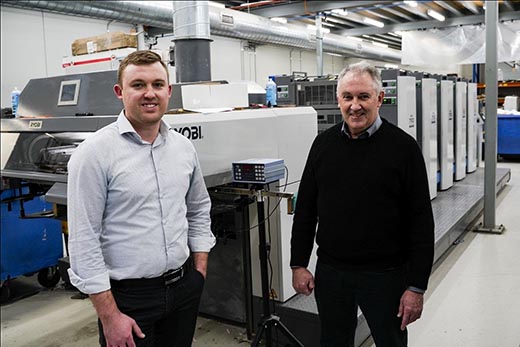CBS Printing Forge Ahead with UV LED System Retrofit
Press release from the issuing company

CBS’s managing partners Nathan Wilson and Stephen Wilson with their Ryobi 754 press, retrofitted with a GEW LeoLED UV curing system.
Australian print and marketing solutions provider CBS has recently upgraded its Ryobi 754G+C+SLD press with a retrofitted GEW UV LED curing system, a move described by managing partner Stephen Wilson as ‘bringing an old machine back to life’.
Established in 1977, CBS Printing is now recognised as a print industry leader in Australia. The family-owned company supplies corporate print and marketing solutions to brands across the country. CBS is led by a forward-thinking management team who are constantly developing the business and their continuous investment in new technology is an essential part of that development programme. The company has been a pioneer of new printing techniques, including the use of UV LED curing systems.
Stephen Wilson has been with CBS for 35 years and is now a joint owner with his eldest son, Nathan. They have steadily built the business and increased the product range. The COVID pandemic hit business hard in early 2020 and they have had to be resourceful and adaptive to maintain a healthy level of business. At that point they ventured into producing food packaging for the first time and this has proven to be a highly successful move, as Stephen Wilson explains: “There were so many hotels and restaurants and so forth that were not able to do their catering in the usual way and so there was a sudden high demand for ready meals and safely pre-packed foods. This line of business really took off for us and has brought in over AUS$1,000,000 in the past 12 months. So there has been an incidental benefit to our business from COVID, to counter the many negatives. And to add to this, the commercial print business is now steadily returning.”
Getting into this lucrative business from a standing start was a considerable challenge and the sales team at CBS had to market themselves aggressively to begin with. They found a gap in the market for the production volumes that suited them, as Wilson explains: “The Australian packaging market features a few key players who are only really interested in jobs of 500,000 and more. We are better suited to producing volumes anywhere between 5,000 and 100,000 meal sleeves, and we have subsequently found a high demand from smaller producers.”
The retrofit installation of the new UV curing system has been pivotal in keeping up with this new demand. The production team at CBS had been running most of the food packaging on their RMGT 920 press because their second press, a Ryobi 754G, was not up to the job. The meal sleeves do not require the 920’s A1 sheet size and yet they were taking up most of the press hours, which is why Wilson decided that action was needed. The 754 was upgraded with a retrofitted GEW LeoLED UV curing system, mounted after the 4th print unit, and this has eliminated the unwanted demand on the 920. Wilson comments: “We can now produce the sleeves without the need for aqueous coatings and although we have had to invest in the new UV system, that investment has effectively brought our 754 back to life. We can push more and more work on to this press, with the confidence that it can now handle it.” The press can handle up to 600micron board with ease, and so the UV system has been the only upgrade necessary, along with the installation of a set of compatible combi rollers.
Wilson continues: “We looked at a few UV systems from various suppliers, but eventually we settled on GEW for two key reasons… we had heard favourable reports about them from others in the industry, but we were also swayed by their remote monitoring and support service, which means we have technical backup for our new system 24/7/365 and this gives us great peace of mind. That said, we haven’t yet had a reason to call on the service, but we know it’s there when we need it.”
The questions remain:- If UV LED curing is so good, what are the barriers to printers adopting the technology? Why is it not more commonly used? Wilson explains his thinking on this: “Trade houses are all running Komoris and Ryobis with UV LED so they are switched on to it. But there’s a lot of other commercial printers that are not running UV, so there is a market there. I think there are many printers out there that just don’t think of a UV LED retrofit as being an option for their press, and of course press manufacturers are more geared to selling new machines, rather than having printers upgrade their older machines with UV LED and bringing them back to life.”
Wilson concludes: “In addition to the new production capabilities we now have with UV LED curing, we are saving substantial sums on our energy bills, we’re saving on coatings and we have dramatically reduced the number of reprints necessary due to problems like set off and dry back. The new UV system has worked wonders for our business.”
- KYOCERA NIXKA INKJET SYSTEMS (KNIS) INTRODUCES BELHARRA, THE NEW WAVE OF PHOTO PRINTERS
- New RISO Printing Unit Offers Easy Integration for Package Printing
- March 2024 Inkjet Installation Roundup
- Inkjet Integrator Profiles: Integrity Industrial Inkjet
- Revisiting the Samba printhead
- 2024 Inkjet Shopping Guide for Folding Carton Presses
- The Future of AI In Packaging
- Inkjet Integrator Profiles: DJM

WhatTheyThink is the official show daily media partner of drupa 2024. More info about drupa programs
© 2024 WhatTheyThink. All Rights Reserved.









Discussion
Join the discussion Sign In or Become a Member, doing so is simple and free